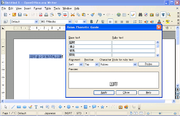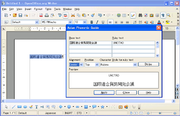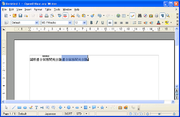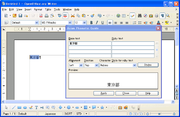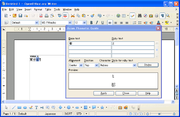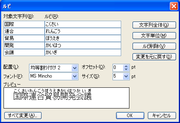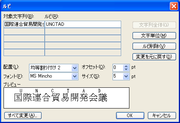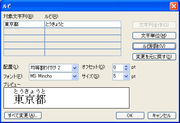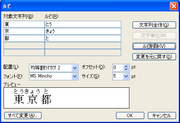Difference between revisions of "User:Bluedwarf/Asian Phonetic Guide"
| Line 24: | Line 24: | ||
[[Image:Asian phonetic guide unctad try integration.png|frameless|none|100px]] | [[Image:Asian phonetic guide unctad try integration.png|frameless|none|100px]] | ||
| − | This operation results in an unexpected situation like the picture below. The 4 parts you cut and pasted would be duplicated. | + | This operation results in an unexpected situation like the picture below. The 4 parts you cut and pasted would be duplicated. |
| + | |||
| + | Of course, there is one simple workaround that you only delete the duplicated parts, but this is quite inconvinient. It would be especially troublesome when you have a lot of wrongly separated seguments in one document. | ||
[[Image:Asian phonetic guide unctad failed integration.png|frameless|none|100px]] | [[Image:Asian phonetic guide unctad failed integration.png|frameless|none|100px]] | ||
| Line 30: | Line 32: | ||
=== Separation === | === Separation === | ||
| − | + | In contrast, OOo sometimes generates longer segments than you expect. In this case, you would try to separate into a couple of segments. | |
| − | For example, here is a word "東京都" which means Tokyo Metropolis. Now try to add ruby | + | |
| + | For example, here is a word "東京都" which means Tokyo Metropolis. Now try to add ruby to this word in OpenOffice.org Writer. You will get the same result shown in the picture below. As you see, this word is recognized as 1 word. | ||
[[Image:Asian phonetic guide tokyo.png|frameless|none|100px]] | [[Image:Asian phonetic guide tokyo.png|frameless|none|100px]] | ||
| − | However, in some conditions, you might want to separate this word into 2 parts. To do so, you have to close Asian Phonetic Guide dialog, and then select 1 part and open the dialog again. This is quite annoying operation. | + | However, in some conditions, you might want to separate this word into 2 parts. To do so, you have to close Asian Phonetic Guide dialog, and then select 1 part and open the dialog again. This is a quite annoying operation. |
[[Image:Asian phonetic guide tokyo try separation.png|frameless|none|100px]] | [[Image:Asian phonetic guide tokyo try separation.png|frameless|none|100px]] | ||
Revision as of 21:34, 4 July 2009
Contents
Abstract
OpenOffice.org Writer has a function for asian phonetic guide, so-called ruby, for Chinese and Japanese, which allows you to add annotative ruby characters to a corresponding Kanji string. To enter ruby on OpenOffice.org Writer, you usually open Asian Phonetic Guide dialog, however, this dialog is a little bit inconvenient.
In this page, first, the background and details of current inconvinience in that dialog are explained. Second, we look into the equivalent feature of other Office suites. At the end, some ideas for improvement of OpenOffice.org are discussed.
Background
OpenOffice.org has a good ability to split Japanese text into grammatical segments even though Japanese text doesn't have spaces between words. This separation process is doen by OpenOffice.org without user intervention. Yet this automatical separation sometimes fails due to complexity and ambiguity of the grammar. It sometimes separates text in wrong position or position which you don't expect. Unfortunately, this problem is essentially (probably) unresovable.
As a result, when you edit ruby text, you may encounter some kinds of inconvinience becase incorrectly split segments are shown in Asian Phonetic Guide dialog, which is described below.
Problems
Integration
If OOo generates smaller segments than you expect, you would try to merge two or more segements into one. However, there is not a good solution for integration of segments.
For example, here is a word "国際連合貿易開発会議" which means UNCTAD in English. Now let's try to add ruby to this word in OpenOffice.org 3.1 Writer. You will get the same result shown in the picture below. As you see, this word are recognized as the combination of 5 words, while you consider it as 1 word.
Then, to combine them into one segument, you would cut the last 4 parts and paste them together into the top text box like the picture below.
This operation results in an unexpected situation like the picture below. The 4 parts you cut and pasted would be duplicated.
Of course, there is one simple workaround that you only delete the duplicated parts, but this is quite inconvinient. It would be especially troublesome when you have a lot of wrongly separated seguments in one document.
Separation
In contrast, OOo sometimes generates longer segments than you expect. In this case, you would try to separate into a couple of segments.
For example, here is a word "東京都" which means Tokyo Metropolis. Now try to add ruby to this word in OpenOffice.org Writer. You will get the same result shown in the picture below. As you see, this word is recognized as 1 word.
However, in some conditions, you might want to separate this word into 2 parts. To do so, you have to close Asian Phonetic Guide dialog, and then select 1 part and open the dialog again. This is a quite annoying operation.
Competitors
Microsoft Office Word 2003
This is Furigana dialog of Microsoft Office Word 2003. When you try to add ruby text to the Japanese text "国際連合貿易開発会議", then you will see the following picture.
As you see, it is similar to OpenOffice.org Writer's one, but you can see some ruby strings are already inserted, which is different point. Microsoft Office Word 2003 has a function that it suggests ruby text automatically.
Anyway, now you want to integrate the seperated 5 words into 1 word. In this case, you can do that by clicking the button "文字列全体" like following.
Ichitaro
Suggestion
Integration and separation
Automatical suggestion of ruby characters
It would be wonderful if OpenOffice.org gave ruby characters for Japanese sentence automatically. That is impossible, but OpenOffice.org could suggest ruby characters by filling out the ruby text entries in Asian Phonetic Guide dialog. This would be very helpful to input ruby text. Sometimes the suggestion might be wrong, but it would not be a big deal because users could still edit ruby text manually in the dialog.
Automatical suggestion of ruby characters can be realized with the help of MS-IME like Japanese_Reconversion.
